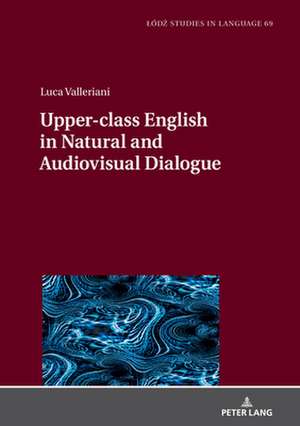Upper-class English in Natural and Audiovisual Dialogue: Lodz Studies in Language
Autor Luca Vallerianien Limba Engleză Hardback – 29 sep 2021
Din seria Lodz Studies in Language
-
 Preț: 523.47 lei
Preț: 523.47 lei -
 Preț: 485.44 lei
Preț: 485.44 lei - 23%
 Preț: 571.33 lei
Preț: 571.33 lei - 23%
 Preț: 452.42 lei
Preț: 452.42 lei - 23%
 Preț: 482.63 lei
Preț: 482.63 lei - 23%
 Preț: 487.37 lei
Preț: 487.37 lei - 23%
 Preț: 485.44 lei
Preț: 485.44 lei - 20%
 Preț: 453.54 lei
Preț: 453.54 lei -
 Preț: 523.29 lei
Preț: 523.29 lei - 23%
 Preț: 450.04 lei
Preț: 450.04 lei - 8%
 Preț: 450.24 lei
Preț: 450.24 lei - 23%
 Preț: 452.84 lei
Preț: 452.84 lei - 23%
 Preț: 484.59 lei
Preț: 484.59 lei - 23%
 Preț: 454.78 lei
Preț: 454.78 lei - 23%
 Preț: 486.77 lei
Preț: 486.77 lei -
 Preț: 401.06 lei
Preț: 401.06 lei -
 Preț: 518.50 lei
Preț: 518.50 lei - 23%
 Preț: 430.56 lei
Preț: 430.56 lei - 23%
 Preț: 489.01 lei
Preț: 489.01 lei - 27%
 Preț: 748.83 lei
Preț: 748.83 lei - 27%
 Preț: 680.46 lei
Preț: 680.46 lei -
 Preț: 460.17 lei
Preț: 460.17 lei -
 Preț: 518.50 lei
Preț: 518.50 lei -
 Preț: 497.19 lei
Preț: 497.19 lei - 23%
 Preț: 570.44 lei
Preț: 570.44 lei -
 Preț: 319.53 lei
Preț: 319.53 lei - 23%
 Preț: 446.81 lei
Preț: 446.81 lei - 20%
 Preț: 1167.25 lei
Preț: 1167.25 lei - 9%
 Preț: 751.25 lei
Preț: 751.25 lei - 8%
 Preț: 416.76 lei
Preț: 416.76 lei - 23%
 Preț: 459.19 lei
Preț: 459.19 lei -
 Preț: 422.51 lei
Preț: 422.51 lei - 8%
 Preț: 422.68 lei
Preț: 422.68 lei - 23%
 Preț: 633.33 lei
Preț: 633.33 lei -
 Preț: 444.71 lei
Preț: 444.71 lei - 23%
 Preț: 621.19 lei
Preț: 621.19 lei - 20%
 Preț: 585.65 lei
Preț: 585.65 lei - 23%
 Preț: 595.35 lei
Preț: 595.35 lei - 23%
 Preț: 466.31 lei
Preț: 466.31 lei - 8%
 Preț: 398.62 lei
Preț: 398.62 lei - 23%
 Preț: 570.57 lei
Preț: 570.57 lei - 23%
 Preț: 439.44 lei
Preț: 439.44 lei - 23%
 Preț: 553.67 lei
Preț: 553.67 lei - 23%
 Preț: 467.05 lei
Preț: 467.05 lei - 23%
 Preț: 597.86 lei
Preț: 597.86 lei - 20%
 Preț: 686.06 lei
Preț: 686.06 lei - 23%
 Preț: 468.27 lei
Preț: 468.27 lei
Preț: 371.02 lei
Nou
Puncte Express: 557
Preț estimativ în valută:
71.01€ • 73.86$ • 59.51£
71.01€ • 73.86$ • 59.51£
Carte tipărită la comandă
Livrare economică 13-27 martie
Preluare comenzi: 021 569.72.76
Specificații
ISBN-13: 9783631862964
ISBN-10: 3631862962
Pagini: 148
Dimensiuni: 148 x 210 mm
Greutate: 0.39 kg
Editura: Peter Lang Copyright AG
Seria Lodz Studies in Language
ISBN-10: 3631862962
Pagini: 148
Dimensiuni: 148 x 210 mm
Greutate: 0.39 kg
Editura: Peter Lang Copyright AG
Seria Lodz Studies in Language
Notă biografică
Luca Valleriani obtained a PhD in English Studies at the Sapienza University of Rome. His main research interests are sociolinguistics and the analysis of telecinematic dialogue. He is a member of the AIA (Associazione Italiana di Anglistica) and he is co-coordinator of the Dialects in Audiovisuals project.
Cuprins
Linguistic features of upper-class English
History of upper-class English
Upper-class English in real life
Upper-class English in cinema and TV
Descriere
This volume deals with the language of the British upper class in natural face-to-face dialogue and how this is rendered in audiovisual media. Previous scholarly insights on the topic are discussed in the light of new evidence gathered from the qualitative analysis of some recorded audiovisual texts.
